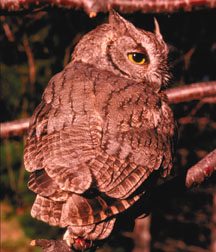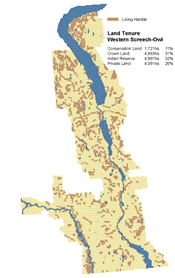|
Habitat Atlas for Wildlife at Risk
Western Screech-Owl
Otus kennicottii macfarlanei

Western
Screech-Owl
|

- Length: 18-25 cm; wingspan: 55 cm.
- Small owl with conspicuous ear tufts and yellow
eyes.
- Mottled brownish-grey.
- More often heard than seen; two common calls are
a hollow, whistled double trill and a series of low
hoots
that speed up toward the end like a bouncing ball.
- The closely related Flammulated Owl (Otus flammeolus)
is much smaller, has dark eyes and shorter ear tufts.
Status:
British Columbia Red List
Special Significance
In British Columbia's dry Southern Interior, Western
Screech-Owls are restricted to the moist woodlands
along streams and lakes. This species is at risk
because of its small provincial population size and
loss of breeding and foraging habitat. Landowners
living in or near suitable screech-owl habitat can
assist these birds by protecting remaining riparian
habitats, retaining large, standing dead trees and
constructing nest boxes. Further studies are required
to determine the Western Screech-Owl's population
density, habitat use and home range size.
Distribution
- In the Southern Interior, known to breed only in the Okanagan
Valley.
- May breed occasionally in Thompson and Kootenay valleys,
but the few records there are mainly in the
fall and winter.
- Elevational range: below 600 metres.
Habitat
- Deciduous woodlands along lakeshores, streams, and rivers.
- Nest trees are generally live or dead deciduous or
coniferous trees; owls use natural cavities or
abandoned cavities made by Northern Flickers and Pileated Woodpeckers.
- Day roosts are in deciduous or coniferous tree cavities,
nest boxes, buildings, trees, vines and crevices
in cliffs.
- Owls frequent urban and suburban areas where large
trees are present.
Reproduction
- Owls start nesting in early April; 4 to 5 eggs are commonly laid.
- Broods appear from mid-May to early June.
Food Habits
- Screech-Owls are generalists with a diet of insects, voles, mice,
shrews, small birds, amphibians, earthworms, slugs, reptiles and fish.
Threats
- Extensive land development in the Southern Interior
has eliminated and fragmented Western Screech-Owl
foraging and breeding habitat (low elevation coniferous and
deciduous woodlands).
- Large, standing decaying trees are often felled;
these are potential nesting sites.
Management Considerations
- Maintain patches of mature forest 5-10 hectares
in size.
- Retain large, standing coniferous and deciduous
trees in riparian habitats.
- Where large, standing deteriorating trees have
been felled, allow a new generation of trees
to develop; in the meantime, construct and
erect owl boxes to provide suitable nesting sites.
|
References
1. Campbell, R.W., N. K. Dawe, I. McTaggart-Cowan, J. Cooper, G.
Kaiser and M.C. McNall. 1990. Birds of British Columbia: Volume 2.
Royal British Columbia Museum,Victoria, BC.
2. Cannings, R.A., R.J. Cannings and S.G. Cannings.
1987. Birds of the Okanagan Valley, British Columbia. Royal British
Columbia Museum, Victoria, BC.
3. Kaufman, K. 1996. Lives of North American birds.
Houghton Mifflin Company, Boston, New York.
|